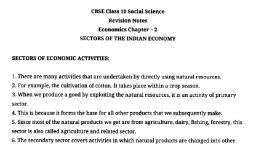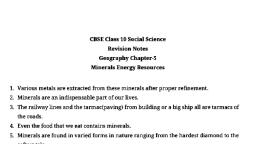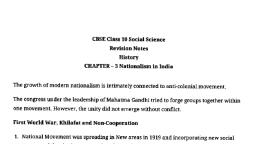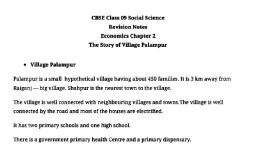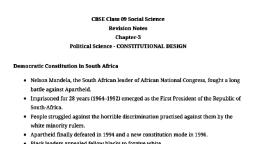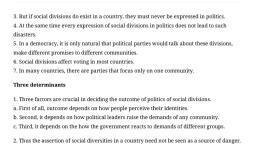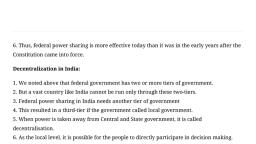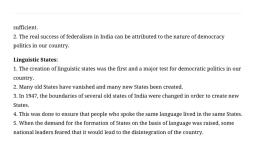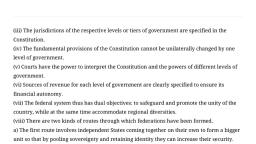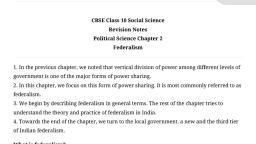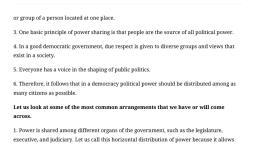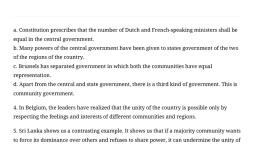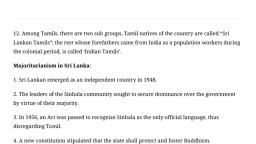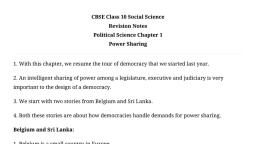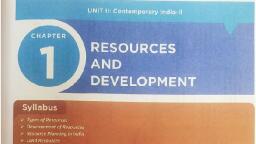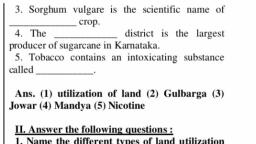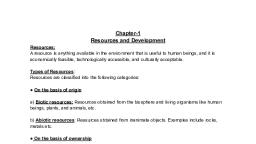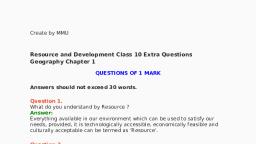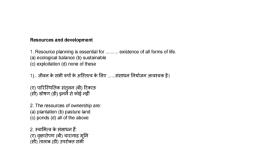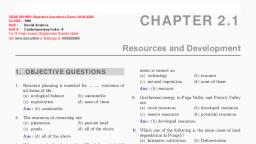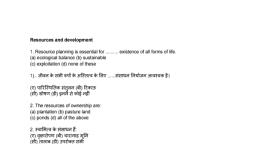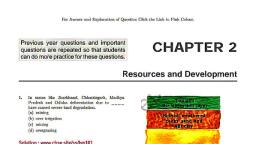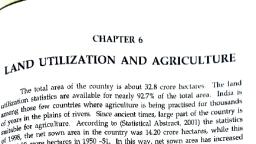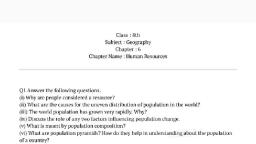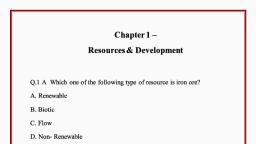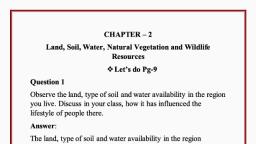Page 1 :
CBSE Class 10 Social Science, Revision Notes, , Geography Chapter-1, Resources and Development, , 1. Resource: Everything available in our environment which can be used to satisfy our, , needs, provided, it is technologically accessible, economically feasible and culturally, , acceptable can be termed as "Resource., 2. TYPES OF RESOURCES: These resources can be classified in the following ways(a) On the basis of origin -biotic and abiotic, (b) On the basis of exhaustibility - renewable and non-renewable, , c) On the basis of ownership - individual, community, national and international, , d) On the basis of status of development -potential, developed staock and reserves., Biotic Resources obtained from biosphere and have life such as human beings, flora, , and fauna, fisheries, livestock etc., All those things which are composed of non-living things are called abiotic resources., For example, rocks and metals., , Renewable Resources can be renewed or reproduced by physical, chemical or, mechanical processes For example, solar and wind energy., water, forests and wildlife,, , etc., Non-Renewable Resources occur over a very long geological time. Minerals and fossil, fuels are examples of such resources. These resources take millions of years in their, formation., Individual Resources are owned privately by individuals. Example: Many farmers, own land which is allotted to them by government against the payment of revenue., , Community Owned Resources are resources which are accessible to all the members, of the community. Example: Village commons (grazing grounds, burial grounds,, , village ponds, etc.) public parks, picnic spots,playgrounds in urban areas etc., National Resources Technically, all the resources belong to the nation. The country
Page 2 :
has legal powers to acquire even private property for public good., International Resources are international institutions which regulate some resources., , The oceanic resources beyond 200 km of the Exclusive Economic Zone belong to open, acean and no individual country can utilise these without the concurrence of, international institutions., Potential Resources: Resources which are found in a region, but have not heen, utilised. For example, the western parts of India particularly Rajasthan and Gujarat, , have enormous potential for the development of wind and solar energy, but so far, these have not been developed properly., Developed Resources Resoures which are surveyed and their quality and quantity, have been determined for utilisation., 3. DEVELOPMENT OF, , RES, , URCES, , Resources are vital for human survival as well as for maintaining the quality of life. It was, believed that resources are free gifts of nature. Human beings used them indiscriminately, and this has led to the following major problems:, Depletion of resources for satisfying the greed of few individuals., , Accumulation of resources in few hands, which, in turn, divided the society into two, segments ie. haves and have nots or rich and poor., Indiscriminate exploitation of resources has led to global ecological crises such as,, global warming, ozone layer depletion, environmental pollution and land, , degradation., REsOURCES, Natural, , Renewable, Continuous or, , flow eg wind., , Human, , Non-Rehewable, Biological, , Recyclable e.g, metals, , Water, , Nalural, , Vegetation (Forests), , wildlife, , Structures, , Quantiiy a d, , and institutlons, , Quality, , Non Recyclable, cg. Fossil fueis
Page 3 :
4. Resource, , Planning in India: It involves:, , regions of the country. This, estimation and, involves surveying, mapping and qualitative and quantitative, , identification and, , inventory of resources, , the, , across, , measurement of the resources., , .Evolving a planning structure endowed with appropriate, , technology, skill and, , institutional set up for implementing resource development plans., , Matching, , the, , resource, , development plans with, , overall national development, , plans., , 5. Conservation of Resources:, , Resource conservation at various levels is important., , Gandhiji was very apt in voicing his, , concern, , about, , resource, , conservation in these, , words: "There is enough for everybody's need and not for any body's greed.", 6. LAND UTILISATION, , 27%, , +3, , Plains, Mountains, , Plateaus, 30%, , Land resources are used for the following, purposes:, Forests, , Land not available for cultivation, , (a) Barren and waste land, b) Land put to non-agricultural uses, e.g. buildings, roads, factories, etc., , Other uncultivated land (excluding fallow land), (a) Permanent pastures and grazing land,, (b) Land under miscellaneous tree crops groves (not included in net sown area),
Page 4 :
(c) Cultruable waste land (left uncultivated for more than 5 agricultural years)., , Fallow lands, (a) Current fallow-left without cultivation for one or less than one agricultural year),, , b) Other than current fallow-left uncultivated for the past 1 to 5 agriculrural years)., N e t sOwn area, , Area sown more than once in an agricultural year plus net sown area is known as gross, cropped area., , 7. Land use Pattern in India:, General land use Categories 1960-61, , General land use Categories 2002-03, , Reportung Area: 100 per cent, 18.1I1%, , .26%, , 22.57%, , 43.41%, , -12.01%b, 6.29%, , 7.929%, , 4.95%, , 4.71%, , 3.45%, , 1.50%, 3., , 3.50%, , .B", , 4411O%, , 7.03 3.82%, , Forest, , Culturable Waste land, , Barren and waste land, , Fallows other than Current Fallow, , Area under non-agrieultural use, , Permanent Pastures and Grazing land, , Current, , Fallow, , Net Sown Area, , Area under mise. Tree crops and Groves, , Total geographical area ofIndia is 3.28 million sq. km., Land use data however is available only for 93% of the total area because the land use, , reporting far most of the North-East States except Assam has not been done fully., Some area of Jammu and Kashmir occupied by Pakistan and China have also not been, , surveyed., The land under permanent pasture has also decreased.
Page 5 :
Fallow land - left without cultivation far one or less than one agricultural year., , Net, , sown area, , total -total area sown in an agricultural year., , More net sown area in Punjab and Haryana., Less net sown area in Arunachal Pradesh, Mizoram, Manipur and Andaman, , Nicobar Islands., National Forest Policy in India in 1952., Waste land includes rocky, Arid and desert area and land put to other non, , agricultural uses includes settlements, roads, railways, industry etc., Continuous use of land over a long period of time without taking appropriate, measures to conserve and manage it., 8. LAND DEGRADATION AND CONSERVATION MEASURES, , At present, there are about 130 million hectares of degraded land in India., Some human activities such as deforestation, over grazing, mining and quarrying too, , have contributed significantly in land degradation., I n states like Jharkhand, Chhattisgarh, Madhya Pradesh and Orissa deforestation due, to, , mining have caused severe land degradation., , I n states like Gujarat, Rajasthan, Madhya Pradesh and Maharashtra overgrazing is, one, , of the main reasons for land, , I n the states, , degradation., , Haryana, western Utar Pradesh,, of, Punjab,, for land degradation., , over, , irrigation is responsible



